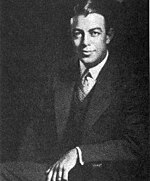Benjamin Whorf
Benjamin Lee Whorf (April 24, 1897 – July 26, 1941) was an American linguist. He is best known as one of the creators of the Sapir–Whorf hypothesis.
Biography
Born in Winthrop, Massachusetts, the son of Harry and Sarah (Lee) Whorf, Benjamin Lee Whorf graduated from the Massachusetts Institute of Technology in 1918 with a degree in chemical engineering and shortly afterwards began work as a fire prevention engineer (inspector) for the Hartford Fire Insurance Company, pursuing linguistic and anthropological studies as an avocation. Another employee of that Company during the entire time Whorf worked there was Wallace Stevens.
In 1931, Whorf began studying linguistics at Yale University under the famed Edward Sapir, whom he so impressed that Sapir gladly supported his academic interests. In 1936, Whorf was appointed Honorary Research Fellow in Anthropology at Yale. In 1937 the university awarded him the Sterling Fellowship. He was a Lecturer in Anthropology from 1937 through 1938, when he began having serious health problems.
Although he never took up linguistics as a profession (he used to say that having an independent, non-academic source of income allowed him better and more freely to pursue his specific academic interests), his contributions to the field were, nevertheless, profound and influential down to the present day.
Whorf's primary area of interest in linguistics was the study of Native American languages, particularly those of Mesoamerica. He became quite well known for his work on the Hopi language, and for a theory he called the principle of linguistic relativity. He disseminated his ideas not only by publishing numerous technical articles, but also by writings accessible to lay readers and by giving popular lectures (he was a captivating speaker), and through articles accessible to lay readers. The Sapir-Whorf hypothesis primarily dealt with the way that language affects thought. Also sometimes called the Whorfian hypothesis, this theory claims that the language a person speaks affects the way that he or she thinks, meaning that the structure of the language itself affects cognition.
Some of Whorf's early work on linguistics and particularly on linguistic relativity was inspired by the reports he wrote on insurance losses, in which misunderstanding based on linguistic confusion had been a contributing factor. In one famous incident which he recounts in his essay "The Relation of Habitual Thought and Behavior to Language" (Whorf, 1956/1997), Whorf recounts how the idea of how language affects thought first came to him. Whorf was working as an investigator for a fire insurance company; his job was to investigate the causes of industrial fires. In his own words:
- "My analysis was directed toward purely physical conditions, such as defective wiring, presence of lack of air spaces between metal flues and woodwork, etc., and the results were presented in these terms. ... But in due course it became evident that not only a physical situation qua physics, but the meaning of that situation to people, was sometimes a factor, through the behavior of people, in the start of a fire. And this factor of meaning was clearest when it was a LINGUISTIC MEANING [Whorf's emphasis], residing in the name or the linguistic description commonly applied to this situation. Thus, around a storage of what are called 'gasoline drums,' behavior will tend to a certain type, that is, great care will be exercised; while around a storage of what are called 'empty gasoline drums,' it will tend to be different -- careless, with little repression of smoking or of tossing cigarette stubs about. Yet the 'empty' drums are perhaps the more dangerous, since they contain explosive vapor. Physically, the situation is hazardous, but the linguistic analysis according to regular analogy must employ the word 'empty,' which inevitably suggests a lack of hazard. The word 'empty' is used in two linguistic patterns: (1) as a virtual synonym for 'null and void, negative, inert,' (2) applied in analysis of physical situations without regard to, e.g., vapor, liquid vestiges, or stray rubbish, in the container." (Whorf, 1956, p. 135)
In studying the cause of a fire which had started in the above described conditions, Whorf concluded that it was thinking of the "empty" gasoline drums as "empty" in the meaning described in the first definition (1) above, that is as "inert," which lead to a fire he investigated. His papers and lectures featured many other examples from his insurance work, as above, to support his belief that language shapes understanding.
Less well known, but important, are his contributions to the study of the Nahuatl and Maya languages. He claimed that Nahuatl was an oligosynthetic language (a claim that would be brought up again some twenty years later by Morris Swadesh, another controversial American linguist). Regarding Maya, he focused on the linguistic nature of the Mayan writing, claiming that it was syllabic to some degree (a claim that has been proven right by Linda Scheele et al. over the past decade).
Whorf died of cancer at the age of 44. He is mainly remembered for a posthumous collection of his work, titled Language, Thought, and Reality, whose first edition appeared in 1956.
Selected bibliography
- Whorf, Benjamin Lee [1933] (1975). The Phonetic Value of Certain Characters in Maya Writing. Millwood, N.Y.: Krauss Reprint.
- Whorf, Benjamin Lee [1942] (1970). Maya Hieroglyphs: An Extract from the Annual Report of the Smithsonian Institution for 1941. Seattle: Shorey Book Store. ISBN 0-8466-0122-2.
- Whorf, Benjamin Lee (1943). Loan-words in Ancient Mexico. New Orleans: Tulane University of Louisiana.
- Carroll, John B. (ed.) [1956] (1997). Language, Thought, and Reality: Selected Writings of Benjamin Lee Whorf. Cambridge, Mass.: Technology Press of Massachusetts Institute of Technology. ISBN 0-262-73006-5.
External links
da:Benjamin Lee Whorf de:Benjamin Whorf et:Benjamin Whorf ja:ベンジャミン・ウォーフ pl:Benjamin Lee Whorf
